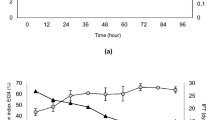Abstract
The aim of the present study was to investigate the separation of oil from water using a bench-scale DAF prototype with the addition of biosurfactants isolated from Pseudomonas cepacia CCT6659 and Bacillus cereus UCP1615. The best operating conditions for the DAF prototype were determined using a central composite rotatable design. The results demonstrated that the biosurfactants from P. cepacia and B. cereus increased the oil separation efficiency from 53.74% (using only microbubbles) to 94.11 and 80.01%, respectively. The prediction models for both DAF-biosurfactant systems were validated, showing an increase in the efficiency of the DAF process from 53.74% to 98.55 and 70.87% using the formulated biosurfactants from P. cepacia and B. cereus, respectively. The biosurfactant from P. cepacia was selected as the more promising product and used for the treatment of oily effluent from a thermoelectric plant, achieving removal rates ranging between 75.74 (isolated biosurfactant) and 95.70% (formulated biosurfactant), respectively.





Similar content being viewed by others
References
Santos DKF, Rufino RD, Luna JM et al (2016) Biosurfactants: multifunctional biomolecules of the 21st century. Int J Mol Sci 17:401. https://doi.org/10.3390/ijms17030401
Aliff Radzuan MR, Abia-Biteo Belope MA, Thorpe RB (2016) Removal of fine oil droplets from oil-in-water mixtures by dissolved air flotation. Chem Eng Res Des 115:19–33. https://doi.org/10.1016/j.cherd.2016.09.013
Mishra AK, Kumar GS (2015) Weathering of oil spill: modeling and analysis. Aquat Proc 4:435–442. https://doi.org/10.1016/j.aqpro.2015.02.058
Rubio J, Smith RW (2002) Overview of flotation as a wastewater treatment technique. Miner Eng 15:139–155. https://doi.org/10.1016/S0892-6875(01)00216-3
Almeida DG, Soares da Silva R, de CF, Luna JM, et al (2016) Biosurfactants: promising molecules for petroleum biotechnology advances. Front Microbiol 7:1718. https://doi.org/10.3389/fmicb.2016.01718
CONAMA (2011) Brazilian National Council for the Environment—Resolution 430/2011. Diário of da União 9. https://doi.org/10.1073/pnas.0703993104
Watcharasing S, Kongkowit W, Chavadej S (2009) Motor oil removal from water by continuous froth flotation using extended surfactant: effects of air bubble parameters and surfactant concentration. Sep Purif Technol 70:179–189. https://doi.org/10.1016/j.seppur.2009.09.014
CONAMA (2007) Brazilian National Council for the Environment—Resolution 393/2007. 01–08
Rocha e Silva FCP, Rocha e Silva NMP, de Moura AE et al (2015) Effect of biosurfactant addition in a pilot scale dissolved air flotation system. Sep Sci Technol 50:618–625. https://doi.org/10.1080/01496395.2014.957319
Albuquerque CF, Luna-Finkler CL, Rufino RD et al (2012) Evaluation of biosurfactants for removal of heavy metal ions from aqueous effluent using flotation techniques. Int Rev Chem Eng 4:156–161
Menezes CTB, Barros EC, Rufino RD et al (2011) Replacing synthetic with microbial surfactants as collectors in the treatment of aqueous effluent produced by acid mine drainage, using the dissolved air flotation technique. Appl Biochem Biotechnol 163:540–546. https://doi.org/10.1007/s12010-010-9060-7
Silva R, de C, Almeida, Rufino DG RD, et al (2014) Applications of biosurfactants in the petroleum industry and the remediation of oil spills. Int J Mol Sci Int J Mol Sci 15:12523–12542. https://doi.org/10.3390/ijms150712523
Luna JM, Pinto AAL, Isabel M et al (2018) Production in bioreactor and application of biosurfactant in dissolved air flotation for the treatment of industrial effluents. Chem Eng Trans 64:559–564. https://doi.org/10.3303/CET1864094
Soares da Silva R, de CF, Rufino, Luna RD JM, et al (2013) Enhancement of biosurfactant production from Pseudomonas cepacia CCT6659 through optimisation of nutritional parameters using response surface methodology. Tenside Surfactants Deterg 50:137–142. https://doi.org/10.3139/113.110241
Almeida SR, de CFS, Luna JM, et al (2017) Response surface methodology for optimizing the production of biosurfactant by Candida tropicalis on industrial waste substrates. Front Microbiol 8:157. https://doi.org/10.3389/fmicb.2017.00157
Silva IA, Helena A, Resende M, Padilha NM (2018) Aplication of biosurfactants produced by Bacillus cereus and Candida sphaerica in the bioremediation of petroleum derivative in soil and Water. Chem Eng Trans 64:1–6
Rita de Cássia F, Almeida DG, Meira HM, et al (2017) Production and characterization of a new biosurfactant from Pseudomonas cepacia grown in low-cost fermentative medium and its application in the oil industry. Biocatal Agric Biotechnol. https://doi.org/10.1016/J.BCAB.2017.09.004
Costa SGVAO, Nitschke M, Haddad R et al (2006) Production of Pseudomonas aeruginosa LBI rhamnolipids following growth on Brazilian native oils. Process Biochem 41:483–488. https://doi.org/10.1016/j.procbio.2005.07.002
Freitas BG, Brito JGM, Brasileiro PPF et al (2016) Formulation of a commercial biosurfactant for application as a dispersant of petroleum and by-products spilled in oceans. Front Microbiol 7:1646. https://doi.org/10.3389/fmicb.2016.01646
Rufino RD, Luna JM, Marinho PHC et al (2013) Removal of petroleum derivative adsorbed to soil by biosurfactant Rufisan produced by Candida lipolytica. J Pet Sci Eng 109:117–122. https://doi.org/10.1016/j.petrol.2013.08.014
Lins JM, Dos Santos LB, Dos Santos VA, Sarubbo LA IndLINS JM et al (2017) Industrial reuse of water from chemical washing of residual frying oil. Chem Eng Trans 57:523–528. https://doi.org/10.3303/CET1757088
Soares da Silva RCFS, de Almeida DG, Brasileiro PF, Diniz R (2018) Production, formulation and cost estimation of a commercial biosurfactant. Biodegradation. https://doi.org/10.1007/s10532-018-9830-4
Acknowledgements
This study was funded by the Foundation for the Support of Science and Technology of the State of Pernambuco (FACEPE), the Research and Development Program from National Agency of Electrical Energy (ANEEL), the Thermoelectric Company of Candeias (Global Group) code PD-06961-0005/2016, the National Council for Scientific and Technological Development (CNPq) and the Coordination for the Improvement of Higher Level Education Personnel (CAPES). The authors are grateful to the laboratories of the Centre for Sciences and Technology of the Catholic University of Pernambuco, Brazil.
Author information
Authors and Affiliations
Corresponding author
Ethics declarations
Conflict of interest
This work is free from any conflict of interest.
Rights and permissions
About this article
Cite this article
Silva, E.J., Almeida, D.G., Luna, J.M. et al. Use of bacterial biosurfactants as natural collectors in the dissolved air flotation process for the treatment of oily industrial effluent. Bioprocess Biosyst Eng 41, 1599–1610 (2018). https://doi.org/10.1007/s00449-018-1986-0
Received:
Accepted:
Published:
Issue Date:
DOI: https://doi.org/10.1007/s00449-018-1986-0




